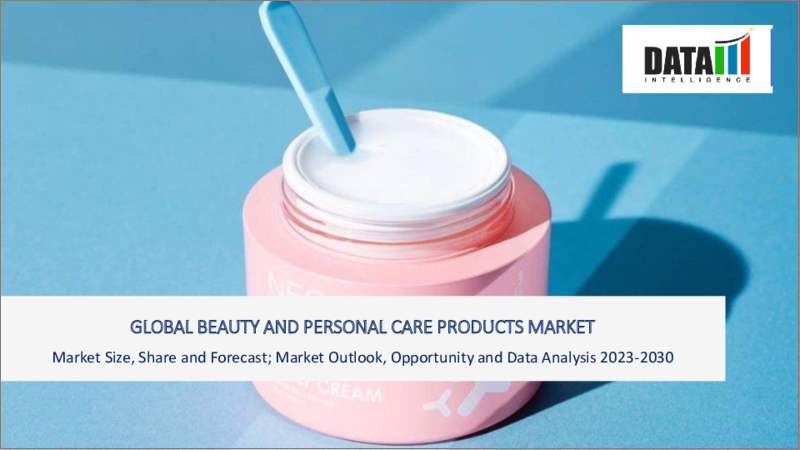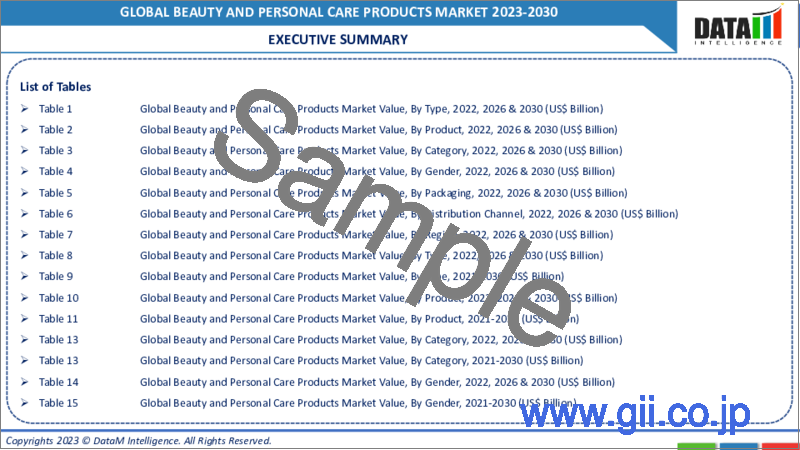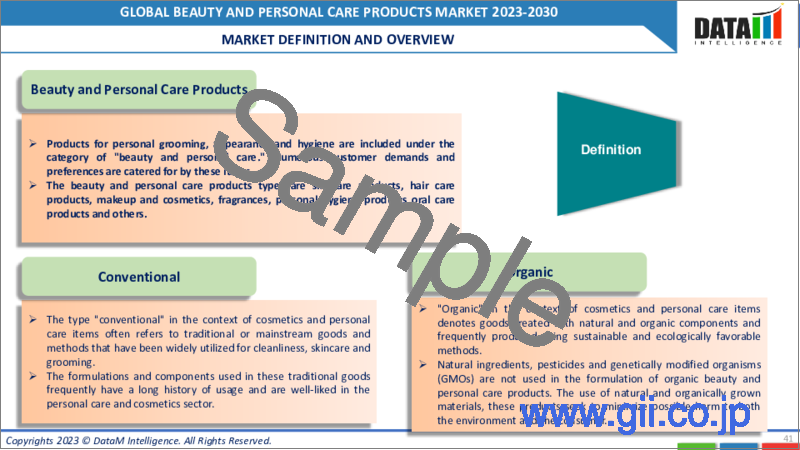|
|
市場調査レポート
商品コード
1290428
美容・パーソナルケア製品の世界市場- 2023-2030Global Beauty and Personal Care Products Market - 2023-2030 |
||||||
カスタマイズ可能
適宜更新あり
|
|||||||
| 美容・パーソナルケア製品の世界市場- 2023-2030 |
|
出版日: 2023年06月12日
発行: DataM Intelligence
ページ情報: 英文 203 Pages
納期: 即日から翌営業日
|
- 全表示
- 概要
- 目次
市場概要
美容・パーソナルケア製品の世界市場は、2022年に4,875億米ドルに達し、2023-2030年の予測期間中に5.1%のCAGRで成長し、2030年には6,242億米ドルに達すると予測されています。
予測期間中に美容・パーソナルケア製品市場のプラス成長をもたらすと予想される要因は、生活水準の向上、品位や社会的関心を重視した製品の楽観的な保有、高級ブランドや超高級ブランドに対する消費者のシフトです。消費者は、パーソナルケア製品に化学物質を多用すると、脱毛、白髪、にきび、色の変化などの悪影響が長期的に生じるため、評判の良い化学物質を含まない製品に目を向けるようになっています。
スーパーマーケットやハイパーマーケットは、ひとつ屋根の下で幅広い品揃えを提供し、住宅地の近くに位置しているためアクセスが容易であることから、世界の美容・パーソナルケア製品市場にとって魅力的な流通経路となっています。インターネット利用の拡大や、より多くの人々にアプローチするための企業によるターゲットマーケティングが、この分野の成長を支えています。さらに、オンラインプラットフォームが提供する大幅な割引やキャンペーンは、同市場における美容・パーソナルケア製品の売上を増加させるでしょう。
市場力学
化学物質を含まない製品への志向の高まり
消費者は、化粧品やパーソナルケア製品に含まれる特定の化学物質による健康被害について、より強く認識するようになってきています。オーガニック製品への関心の高まりに対応するため、市場メーカーは、オーガニック、ビーガン、ナチュラル、化学物質や残酷さを排除した、植物由来のクリーンラベル成分を使用した幅広いオーガニックスキンケア製品を提供し、製品ラインアップを刷新・拡充しています。
例えば、資生堂は2022年4月、地元の垂直農園から無農薬の植物原料を調達する新しいスキンケアブランド「Ule」を発売しました。ナチュラルスキンケアの利点に対する認識が高まった結果、顧客は、製品成分の透明性がより高い、環境に優しく持続可能なナチュラルスキンケア/パーソナルケア製品を求めています。
製品の革新性の高まり
今日の消費者は、自分自身の相続に深く関与しているため、企業は特にカスタマイズされたソリューションを求めています。クラリアントAGは2021年5月、新たな社会的基準に合致したインスピレーションに満ちた処方を提供することを目的に、BeautyForward No.5を発表しました。マスク着用型スキンケアや保湿ハンドクレンザーなど、スキンケアとセルフケアの重なりを重視した癒しの処方が登場しました。
お客様は、ソリューションベースのキットから選ぶことも、データ駆動型プラットフォームからカスタマイズされた処方を手に入れることも可能です。また、ブランドアイテムのパッケージの種類を選ぶこともでき、パーソナライズされたラベルを貼ることもできます。カスタマイズは、ブランドロイヤリティを高め、顧客の喜びを向上させ、堅牢なデータ収集装置を可能にします。障害者のためのEasy Open Lidデザインは、2021年11月にProcter &Gamble Companyの子会社であるOlayによって導入されました。
製品の高額なコスト
美容・パーソナルケア製品には、特殊で高品質な原材料を含む、さまざまなコンポーネントが頻繁に含まれます。コンポーネントは、異なる場所から来たものであったり、製品に価値を与える独自の特徴を持っていたりします。サプライチェーンに複数の中間業者が存在すると、製品が最終消費者に届くまでに価格が高騰する可能性があります。
希少性、独占性、特定の部品に対する強い需要は、すべて価格上昇の要因となり得ます。British Retail ConsortiumとNielsenIQがThe Timesに発表した調査によると、美容製品の価格は過去10年間で最も速いペースで上昇しています。British Beauty Councilによると、シャンプーの価格は昨年8%上昇し、シャワージェルの価格は11%上昇しました。
COVID-19の影響分析
COVID-19の流行後、多くの人が発疹やかゆみなどの皮膚トラブルを抱えました。石鹸や手指消毒剤の使い過ぎにより、手指皮膚炎などの病気を発症した人がいました。医師からは、PPEキットの成果として発疹が報告されました。これらの要因から、消費者がスキンケアを優先するようになり、パーソナルケア部門はCOVID後に拡大しました。
主要なマーケットプレースが閉鎖され、オンラインとオフラインの両方で商品の販売が大きく落ち込んだため、小売業者の新規注文に対する需要は停止しました。人々はスキンケア、カラーコスメ、ヘアケア製品を通常のパーソナルケアのルーチンに導入することが多くなっています。2020年1月、伝説的な化粧品会社であるレブロンは、環境ワーキンググループ(EWG)のクリーンビューティー基準を満たした初の大衆化粧品である「フォトレディプライムプラスパーフェクティング+スムージングプライマー」を発売しました。
ロシア・ウクライナ戦争による影響
輸送制限や封鎖により、世界のサプライチェーンに影響を与えました。ロシアの侵攻により、ウクライナの化粧品部門は深刻な被害を受け、複数のメーカーが生産停止や休業に追い込まれました。ハリコフやドニプロといったウクライナの産業拠点には、ロレアル、ヘンケル、オリフレームといった外資系メーカーだけでなく、何百もの地元の美容・パーソナルケア製品メーカーが立地しています。
P&Gはウクライナでの業務を停止し、現地で働く従業員への避難支援や資金援助を行っていました。しかし、ロシアによるウクライナの主要都市への侵攻と砲撃により、急拡大しているこの地域の事業は事実上停止しています。国連の予測によると、ウクライナの戦争が早期に終結したとしても、同国のGDPは10%減少し、多くの現地生産者が仕事を失うことになると懸念されます。
目次
第1章 調査手法と範囲
- 調査手法
- 調査目的および調査範囲
第2章 定義と概要
第3章 エグゼクティブサマリー
第4章 市場力学
- 影響要因
- 促進要因
- ケミカルフリーへの志向の高まり
- 製品の革新性の高まり
- 抑制要因
- 製品のコスト高
- 機会
- 影響分析
- 促進要因
第5章 産業分析
- ポーターのファイブフォース分析
- サプライチェーン分析
- 価格分析
- 法規制の分析
第6章 COVID-19の分析
第7章 タイプ別
- 従来型
- オーガニック
第8章 製品別
- ヘアケア
- スキンケア
- カラーコスメティック
- フレグランス
- その他
第9章 流通チャネル別
- ハイパーマーケット・スーパーマーケット
- 専門店
- eコマース
- その他
第10章 地域別
- 北米
- 米国
- カナダ
- メキシコ
- 欧州
- ドイツ
- 英国
- フランス
- イタリア
- ロシア
- その他欧州
- 南米
- ブラジル
- アルゼンチン
- その他南米地域
- アジア太平洋地域
- 中国
- インド
- 日本
- オーストラリア
- その他アジア太平洋地域
- 中東・アフリカ地域
第11章 競合情勢
- 競合シナリオ
- 市況ポジショニング/シェア分析
- M&A(合併・買収)分析
第12章 企業プロファイル
- Unilever
- 会社概要
- 製品ポートフォリオと説明
- 財務概要
- 最近の動向
- The Estee Lauder Companies Inc.
- Kao Corporation
- Shiseido Co., Ltd.
- Revlon
- Oriflame Cosmetics S.A.
- Procter & Gamble
- L'Oreal S.A.
- Avon Products, Inc.
- Coty Inc.
第13章 付録
Market Overview
The Global Beauty and Personal Care Products Market reached US$ 487.5 billion in 2022 and is expected to reach US$ 624.2 billion by 2030, growing with a CAGR of 5.1% during the forecast period 2023-2030.
The drivers that are expected to generate positive beauty and personal care products market growth during the forecast period are the rising living standards, the optimistic possession of products that focus on dignity and social attention and the consumer shift towards luxury and ultra-premium brands. Consumers are turning to reputable, chemical-free products as a result of the long-term consequences associated with utilizing too many chemicals in personal care products, such as hair loss, greying, acne, colour change and other adverse effects.
Supermarkets and hypermarkets have become attractive distribution channels for the global beauty and personal care products market because they offer an extensive range of items under a single roof and are ideally located near residential areas for easy access. Growing internet usage and targeted marketing by companies to reach a larger audience have supported segment growth. Furthermore, large discounts and offers given by online platforms would increase the sales of beauty and personal care products in the market.
Market Dynamics
Growing Inclination Towards Chemical Free Products
Consumers are becoming more aware of the health hazards related to certain chemicals often found in cosmetics and personal care items. To capitalize on the growing interest in organic products, market manufacturers have revamped and expanded their product offerings by offering a wide range of organic skincare products featuring plant-based, clean-label ingredients, with claims such as organic, vegan, natural, free of chemicals and cruelty.
In April 2022, Shiseido, for example, released Ule, a new skincare brand that sources pesticide-free botanicals from local vertical farms. As a result of the increased awareness of the benefits of natural skincare, customers are seeking eco-friendly, sustainable, natural skincare/personal care products with better product component transparency.
Rising Product Innovations
Companies want specifically customized solutions since today's consumers are intensely involved in their personal inheritance. Clariant AG launched BeautyForward No. 5 in May 2021, with the purpose of providing inspired formulas matched to emerging societal standards. It included mask-wearing skincare and moisturizing hand cleansers, as well as soothing formulas that emphasized the overlap between skincare and self-care.
Customers may now choose from a choice of solution-based kits or get customized formulations from data-driven platforms. They may even choose the kind of packaging for their branded items, including personalized labels. Customization increases brand loyalty, improves client pleasure and enables a robust data-collecting apparatus. The Easy Open Lid design for people with disabilities was introduced by Olay, a Procter & Gamble Company subsidiary, in November 2021.
High Costs of Products
Beauty and personal care products frequently include a wide range of components, including specialised and high-quality raw materials. The components may come from different locations or have unique features that give value to the products. Multiple intermediaries in the supply chain can lead to price escalations by the time the product reaches the end consumer.
Scarcity, exclusivity or strong demand for specific components can all contribute to pricing increases. According to research published in The Times by the British Retail Consortium and NielsenIQ, beauty prices are rising at the fastest pace in a decade. According to The British Beauty Council, the cost of shampoo has risen by 8% in the last year, while the cost of shower gel has climbed by 11%.
COVID-19 Impact Analysis
Following the COVID-19 outbreak, many had skin problems such as rashes and itching. People developed ailments such as hand dermatitis as a result of the over use of soaps and hand sanitizers. The doctors reported rashes as an outcome of the PPE kits. Because of all of these factors, the personal care sector has expanded post-COVID, as consumers prioritise skin care.
Retailer demand for new orders came to a halt as key marketplaces were shut down and commodities sales suffered significantly, both online and offline. People are increasingly implementing skin care, color cosmetics and hair care products in their regular personal care routines. In January 2020, legendary cosmetics firm Revlon released its PhotoReady Prime Plus Perfecting + Smoothing Primer, the first mass cosmetic product to fulfil the Environmental Working Group's (EWG) clean beauty criteria.
Russia- Ukraine War Impact
Transportation restrictions and lockdowns impacted the global supply chain. The Russian invasion has severely harmed the Ukrainian cosmetics sector, causing several manufacturers to suspend production and close their doors. Hundreds of local beauty and personal care product manufacturers, as well as foreign manufacturers like as L'Oreal, Henkel and Oriflame, are located in Ukraine's industrial hubs such as Kharkiv and Dnipro.
P&G halted operations in Ukraine to provide evacuation aid and financial support to its workers there. However, Russia's invasion and bombardment of major Ukrainian cities has effectively halted operations in this rapidly expanding local sector. According to UN projections, even if Ukraine's war ends early, the country's GDP will decline by 10%, putting many local producers out of work.
Segment Analysis
The global beauty and personal care products market is segmented based on type, product, distribution channel and region.
Rising Awareness of Benefits Using the Organic Products
The organic segment is expected to hold around 30% of the global beauty and personal care products market during the forecast period 2023-2030. Organic cosmetics are made with organically grown components, are healthy for the skin, are cruelty-free and help to maintain the environment and biodiversity. Rising public understanding of the benefits of using organic cosmetics is expected to improve consumer sales globally.
A growing number of manufacturers selling clean and organic beauty and personal care products is also expected to boost the market during the forecast period. Pour Le Monde, Pour Le Monde (PMPM), a skin care brand for acne-prone skin, was released in China in March 2020. It contains organic components such as baobab essence derived from the seeds of baobab plants in Madagascar.
Geographical Analysis
Growing Awareness of Facial and Hairstyling Products in Asia-Pacific
Asia-Pacific is anticipated to have highest growth in the beauty and personal care products market during the forecast period. Growing consumer awareness of cosmetic items such as face makeup, hairstyling and coloring products is likely to boost market expansion in the near future. Shiseido, one of the market's major cosmetics makers, launched Inryu, an ingestible beauty brand that seeks to improve skin health from the inside out, in November 2021.
The need for multipurpose products drives innovation as price-conscious buyers choose goods that provide hydration and skin protection. Companies are continuously advertising medical cosmetics, particularly on social networking platforms like Facebook, Twitter, YouTube and Instagram, where beauty bloggers are popular. Among the top competitors in the Asia-Pacific market are Beiersdorf AG, L'Oreal Group, Procter & Gamble, The Estee Lauder Companies Inc. and Unilever.
Competitive Landscape
The major global players include: Unilever, The Estee Lauder Companies Inc., Kao Corporation, Shiseido Co., Ltd., Revlon, Oriflame Cosmetics S.A., Procter & Gamble, L'Oreal S.A., Avon Products, Inc. and Coty Inc.
Why Purchase the Report?
- To visualize the global beauty and personal care products market segmentation based on type, product, distribution channel and region, as well as understand key commercial assets and players.
- Identify commercial opportunities by analyzing trends and co-development.
- Excel data sheet with numerous data points of beauty and personal care products market-level with all segments.
- PDF report consists of a comprehensive analysis after exhaustive qualitative interviews and an in-depth study.
- Product mapping available as Excel consisting of key products of all the major players.
The global beauty and personal care products market report would provide approximately 61 tables, 59 figures and 203 Pages.
Distribution Channel 2023
- Manufacturers/ Buyers
- Industry Investors/Investment Bankers
- Research Professionals
- Emerging Companies
Table of Contents
1. Methodology and Scope
- 1.1. Research Methodology
- 1.2. Research Objective and Scope of the Report
2. Definition and Overview
3. Executive Summary
- 3.1. Snippet by Type
- 3.2. Snippet by Product
- 3.3. Snippet by Distribution Channel
- 3.4. Snippet by Region
4. Dynamics
- 4.1. Impacting Factors
- 4.1.1. Drivers
- 4.1.1.1. Growing Inclination Towards Chemical Free Products
- 4.1.1.2. Rising Product Innovations
- 4.1.2. Restraints
- 4.1.2.1. High Costs of Products
- 4.1.3. Opportunity
- 4.1.4. Impact Analysis
- 4.1.1. Drivers
5. Industry Analysis
- 5.1. Porter's Five Force Analysis
- 5.2. Supply Chain Analysis
- 5.3. Pricing Analysis
- 5.4. Regulatory Analysis
6. COVID-19 Analysis
- 6.1. Analysis of COVID-19
- 6.1.1. Scenario Before COVID
- 6.1.2. Scenario During COVID
- 6.1.3. Scenario Post COVID
- 6.2. Pricing Dynamics Amid COVID-19
- 6.3. Demand-Supply Spectrum
- 6.4. Government Initiatives Related to the Market During Pandemic
- 6.5. Manufacturers Strategic Initiatives
- 6.6. Conclusion
7. By Type
- 7.1. Introduction
- 7.1.1. Market Size Analysis and Y-o-Y Growth Analysis (%), By Type
- 7.1.2. Market Attractiveness Index, By Type
- 7.2. Conventional*
- 7.2.1. Introduction
- 7.2.2. Market Size Analysis and Y-o-Y Growth Analysis (%)
- 7.3. Organic
8. By Product
- 8.1. Introduction
- 8.1.1. Market Size Analysis and Y-o-Y Growth Analysis (%), By Product
- 8.1.2. Market Attractiveness Index, By Product
- 8.2. Hair Care*
- 8.2.1. Introduction
- 8.2.2. Market Size Analysis and Y-o-Y Growth Analysis (%)
- 8.3. Skin Care
- 8.4. Color Cosmetics
- 8.5. Fragrances
- 8.6. Others
9. By Distribution Channel
- 9.1. Introduction
- 9.1.1. Market Size Analysis and Y-o-Y Growth Analysis (%), By Distribution Channel
- 9.1.2. Market Attractiveness Index, By Distribution Channel
- 9.2. Hypermarkets & Supermarkets*
- 9.2.1. Introduction
- 9.2.2. Market Size Analysis and Y-o-Y Growth Analysis (%)
- 9.3. Specialty Stores
- 9.4. E-commerce
- 9.5. Others
10. By Region
- 10.1. Introduction
- 10.1.1. Market Size Analysis and Y-o-Y Growth Analysis (%), By Region
- 10.1.2. Market Attractiveness Index, By Region
- 10.2. North America
- 10.2.1. Introduction
- 10.2.2. Key Region-Specific Dynamics
- 10.2.3. Market Size Analysis and Y-o-Y Growth Analysis (%), By Type
- 10.2.4. Market Size Analysis and Y-o-Y Growth Analysis (%), By Product
- 10.2.5. Market Size Analysis and Y-o-Y Growth Analysis (%), By Distribution Channel
- 10.2.6. Market Size Analysis and Y-o-Y Growth Analysis (%), By Country
- 10.2.6.1. The U.S.
- 10.2.6.2. Canada
- 10.2.6.3. Mexico
- 10.3. Europe
- 10.3.1. Introduction
- 10.3.2. Key Region-Specific Dynamics
- 10.3.3. Market Size Analysis and Y-o-Y Growth Analysis (%), By Type
- 10.3.4. Market Size Analysis and Y-o-Y Growth Analysis (%), By Product
- 10.3.5. Market Size Analysis and Y-o-Y Growth Analysis (%), By Distribution Channel
- 10.3.6. Market Size Analysis and Y-o-Y Growth Analysis (%), By Country
- 10.3.6.1. Germany
- 10.3.6.2. The UK
- 10.3.6.3. France
- 10.3.6.4. Italy
- 10.3.6.5. Russia
- 10.3.6.6. Rest of Europe
- 10.4. South America
- 10.4.1. Introduction
- 10.4.2. Key Region-Specific Dynamics
- 10.4.3. Market Size Analysis and Y-o-Y Growth Analysis (%), By Type
- 10.4.4. Market Size Analysis and Y-o-Y Growth Analysis (%), By Product
- 10.4.5. Market Size Analysis and Y-o-Y Growth Analysis (%), By Distribution Channel
- 10.4.6. Market Size Analysis and Y-o-Y Growth Analysis (%), By Country
- 10.4.6.1. Brazil
- 10.4.6.2. Argentina
- 10.4.6.3. Rest of South America
- 10.5. Asia-Pacific
- 10.5.1. Introduction
- 10.5.2. Key Region-Specific Dynamics
- 10.5.3. Market Size Analysis and Y-o-Y Growth Analysis (%), By Type
- 10.5.4. Market Size Analysis and Y-o-Y Growth Analysis (%), By Product
- 10.5.5. Market Size Analysis and Y-o-Y Growth Analysis (%), By Distribution Channel
- 10.5.6. Market Size Analysis and Y-o-Y Growth Analysis (%), By Country
- 10.5.6.1. China
- 10.5.6.2. India
- 10.5.6.3. Japan
- 10.5.6.4. Australia
- 10.5.6.5. Rest of Asia-Pacific
- 10.6. Middle East and Africa
- 10.6.1. Introduction
- 10.6.2. Key Region-Specific Dynamics
- 10.6.3. Market Size Analysis and Y-o-Y Growth Analysis (%), By Type
- 10.6.4. Market Size Analysis and Y-o-Y Growth Analysis (%), By Product
- 10.6.5. Market Size Analysis and Y-o-Y Growth Analysis (%), By Distribution Channel
11. Competitive Landscape
- 11.1. Competitive Scenario
- 11.2. Market Positioning/Share Analysis
- 11.3. Mergers and Acquisitions Analysis
12. Company Profiles
- 12.1. Unilever*
- 12.1.1. Company Overview
- 12.1.2. Product Portfolio and Description
- 12.1.3. Financial Overview
- 12.1.4. Recent Developments
- 12.2. The Estee Lauder Companies Inc.
- 12.3. Kao Corporation
- 12.4. Shiseido Co., Ltd.
- 12.5. Revlon
- 12.6. Oriflame Cosmetics S.A.
- 12.7. Procter & Gamble
- 12.8. L'Oreal S.A.
- 12.9. Avon Products, Inc.
- 12.10. Coty Inc.
LIST NOT EXHAUSTIVE
13. Appendix
- 13.1. About Us and Distribution Channel
- 13.2. Contact Us





